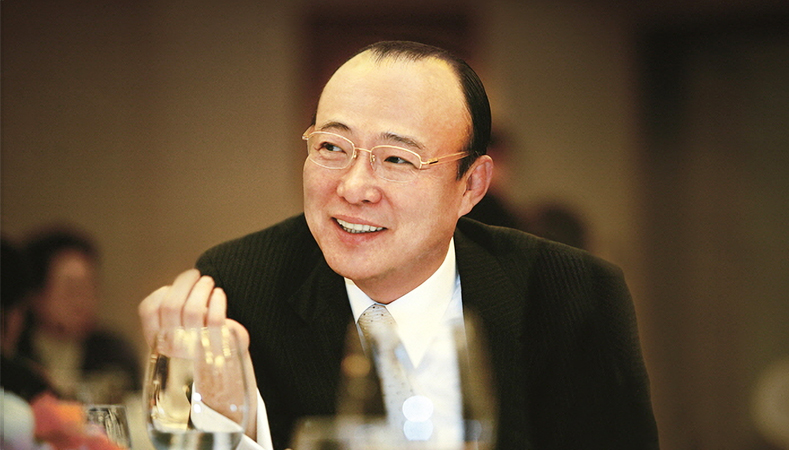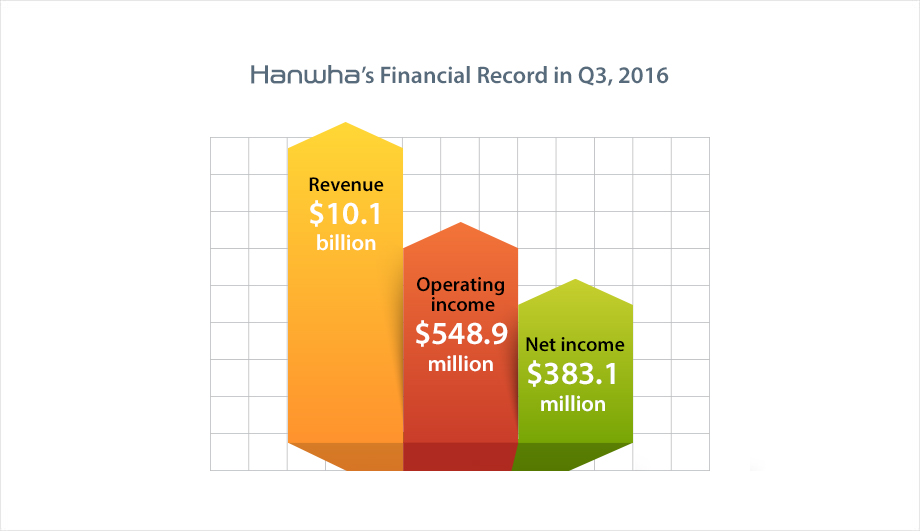2016 CEO of the Year
The Hanwha Group Chairman Seung Youn Kim was ranked first overall on the list of “2016 CEOs of the Year” published by Maekyung Economy, Korea’s premier weekly business magazine. The CEO of the Year award selects and recognizes the year’s top CEOs of public and private corporations who receive widespread acknowledgement in the market for their excellent business achievements and leadership.
The following is a translated version of the article, “2016 CEO of the Year,” published by Maekyung Economy on December 23rd, 2016.

M&A Leadership Has a Track Record of Success
8th in 2015 ▶ 1st in 2016
Chairman Kim’s standing on the “CEO of the Year” list climbed seven steps in a single year.
Few other companies could claim the level of success achieved by Hanwha in 2016.
The recession that has persisted over the past several years has been forcing companies to cut back on their investments. Not so, however, for Hanwha. The company made a strong investment in 2014 in a headline-grabbing deal with Samsung in 2014. As a result, almost every Hanwha company has posted excellent results. It has been smooth sailing for most Hanwha business units including solar energy, finance, petrochemicals and defense. Hanwha recorded the highest quarterly operating profits in the third quarter in 2016 since releasing consolidated earnings in 2011. Industry insiders have even commented that “Hanwha did everything right in 2016.”
Hanwha was ranked 277th on the Fortune Global 500 list in 2016, up 52 places from 392th, 2015, the largest increase for a Korean company.
Having placed 8th on the CEO of the Year list in 2015, Hanwha’s Chairman Kim was able to take the top spot by being ranked 1st in 2016 in financial performance as well as in the top five in all other categories, including innovation (4th), social responsibility (4th), and economic growth (5th).

Hanwha received the highest marks in finance. Hanwha announced consolidated revenues of $10.1 billion for the third quarter, 2016, with operating income of $548.9 million and net income of $383.1 million. Year-on-year revenues rose by 8%, operating profits by 544.3% and net profits by 193.3%. Net income attributable to shareholders totaled $88.95 million, successfully turning around into the black.
Market insiders forecast Hanwha’s growth to continue in the fourth quarter, 2016. Some are even cautiously predicting the operating income in 2016 to exceed $1.664 billion, which would be a threefold increase over last year, 2015. These numbers provided the foundations for Hanwha taking the top spot in finances over other companies.
What enabled Hanwha to achieve such a remarkable turnaround, when operating income was only $416 million as recently as 2014?
Industry experts credit the “big deal” that took place between Samsung and Hanwha in late 2014 in petrochemicals and defense as one of the key factors. Many voiced worries about Hanwha Group when the M&A was first announced. The petrochemical industry had been struck by severe malaise at the time. Some observers derided the deal as “Hanwha taking on an ailing subsidiary.” However, the deal proved to be a stroke of genius. Hanwha Total Petrochemical (formerly Samsung Total Petrochemical) subsidiaries, which officially became a part of Hanwha Group in April 2015, have now become the core of the Group. Strong synergy with existing Hanwha companies have allowed the new addition to significantly contribute to the Group’s rising earnings. For the six quarters lasting from Q2, 2015 to Q3, 2016, Hanwha Total Petrochemical posted an operating income of approximately $1.498 billion, the largest in the history of the company.
Hanwha Chemical had an operating income of approximately $532.57 million in 2016, with Hanwha Techwin also driving the Group’s earnings growth with income of approximately $99.85 million over the same period. The acquisition of Doosan DST, a defense company formerly part of the Doosan Group, almost instantly boosted Hanwha Techwin’s revenue to $3.329 billion in 2016.
Strong showings also came from finance and solar energy.
Hanwha Life’s total assets amount to only $24.182 billion when Hanwha Group acquired Korea Life Insurance (currently Hanwha Life) in 2002. Steady increases in assets enabled the company’s total assets to exceed $41.677 billion by 2009. Annual increases of nearly $8.3 billion allowed total assets to grow to the current level of $82.2 billion. Earnings numbers are also excellent. Hanwha Life recorded its highest-ever operating income of $243.65 million in the third quarter, 2016. Hanwha Q CELLS, the Group’s solar energy division, has posted profits for six straight quarters.
Financial performance is not the only notable achievement. Innovation management is another strong area of excellent. One of its most prominent milestones is the “organizational culture excellence initiative” announced in October 2016. Marking the 64th anniversary of the company’s founding, Hanwha became the first among Korea’s top ten business groups to adopt a one month sabbatical for all of the Group’s companies.
The policy will grant a month of paid vacation after each promotion to associate manager, assistant manager and general manager, or for long-term service (every five years). Salary will be provided in full for the entire month. A Hanwha spokesperson said, “The sabbatical program was created to allow time for self-reflection about a new position in the company and a chance to orient oneself and make plans for a new set of responsibilities,” adding that “the program has been enthusiastically received by our employees.”
Chairman Kim also introduced a “flextime” workday policy that allows employees to manage their own workday schedules in order to boost work efficiency. For companies that are unable to utilize flextime due to the unique nature of their business and operational environments, the lunch hour was expanded to two hours. Team leaders will also be required to leave the office no later than five o’clock at least twice a week, as an incentive to wrap up the day’s work within the official working hours.
An internal “job market” system was also introduced. Employees will be able to apply for a newly-vacated position and candidates will be screened and transferred as part of an effort to help employees better design and manage their career paths.
Chairman Kim said, “Our mindset must grow along with the size of our business and our market presence,” adding that “the goal and dream of Hanwha should be to drive out bureaucracy, complacency and half-heartedness that can make an organization decrepit, and instead strive to go against the relentless flow of time to always remain young and vibrant.”
Corporate social responsibility (CSR) is another area of distinction for Chairman Kim. Hanwha has continued to engage in CSR actives based on the company’s founding principle, “事業報國 (pronunciation:sah-up-bo-gook),” which means “contributing to the nation and society through business.” In honor of Hanwha’s 50th anniversary in 2002, Hanwha reorganized its outreach programs to make them even more effective. In 2007, Hanwha established the Hanwha Social Responsibility Center.
“Going Further Together”
This has been the core philosophy behind Hanwha’s social responsibility programs in a wide variety of areas including culture, sports and the arts. The company runs a “matching grant” policy in which the company donates an additional 150% of any charitable giving done by a Hanwha employee. The company also operates a paid volunteering service that allows employees to take time off with pay to engage in volunteer activities for disadvantaged members of the community.
Hanwha Group also works to bring art and culture to marginalized groups in our society with a variety of performance programs including the Orchestra Festival which the company has sponsored for 17 years since 2000, as well as the Hanwha Pop and Classic Journey, which has been visiting provincial cities to provide musical performances since 2004. The Seoul International Fireworks Festival, held each fall on the banks of the Han River, is another prominent social welfare program by Hanwha.
Hanwha also provides assistance for installing solar power generation equipment for welfare facilities in Korea through the Happy Sunshine Campaign, an eco-friendly CSR activity which the company runs in conjunction with other participating businesses.


